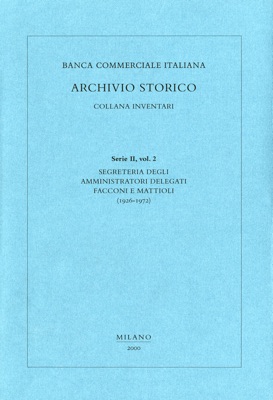
Segreteria degli Amministratori Delegati M. Facconi e R. Mattioli
1925-1972
This analytical inventory provides an individual description of each document.
The Introduction includes biographical and professional profiles of the bank’s Managing Directors between 1933-1955 (Mattioli, Facconi, Alberto d’Agostino and Antonio Rossi) and the executives – most of them young, or very young, like Giovanni Malagodi – who successfully converted Comit from universal bank to ordinary credit bank in the 1930s.
These are the key stages in the restructuring process: the departure from financial dealings, the close monitoring of the treasury and economic indicators, branch autonomy (“independent” in terms of business and dependent in terms of accounting, but with their own profit and loss accounts), moving banking work towards small and medium-sized businesses, studying “local economies” and credit facilities (with the creation of Form 253), the strengthening of its placing power, releasing the placing of securities from an excessive interest in the fate of businesses, selecting and trimming down middle management (by abolishing “intermediate roles”), a determined approach to staff instruction through “invisible” training (rotation between the branches and the Central Administration) and – in a highly modern, successful move – the introduction of administrative routines designed to train personnel in new tasks and create a widely-shared company culture.
Finally, the documents chart how close business and political relations were maintained with foreign countries, mitigating the effects of foreign exchange control, self-sufficiency policy and the War.
Scholars are thus given the chance to read unpublished documents written by Raffaele Mattioli, eminent banker and “one of the most refined writers outside of literature”, as he was described by Gianfranco Contini.